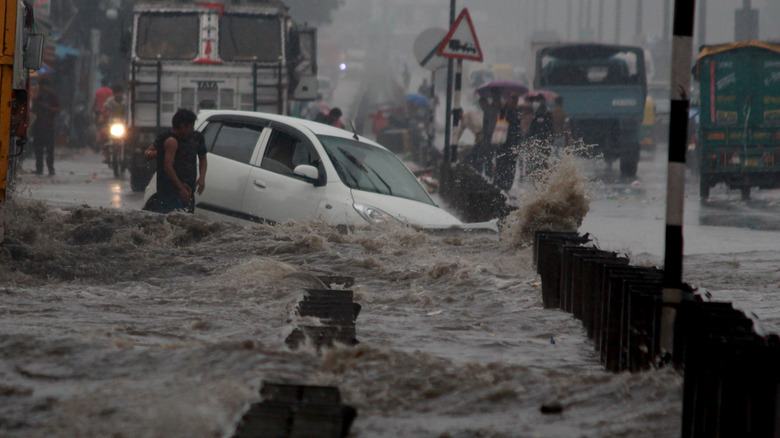What Is A 1,000-Year Flood?
With two "1,000-year" floods taking place in St. Louis and Kentucky in the same week, it has many people wondering, what exactly is a 1,000-year flood anyway? Here's a hint: it's not a storm that takes place every thousand years. Instead, a 1,000-year flood can be thought of as a statistical probability used by meteorologists to determine the likelihood of certain weather events.
According to the U.S. Geological Survey, the term "1,000-year flood" is a colloquial way of stating that a flood of a certain magnitude has around a 1 in 1,000 chance of happening in a given year. In other words, it's likely there will only be a flood that large in an area once in a thousand-year time period on average. This can vary depending on weather conditions over that time period. With climate change affecting weather patterns, it's possible we may see an increasing number of floods over the coming decades (via the Environmental Protection Agency).
A 1 in 1,000 year flood is not a hard and fast rule
It's worth noting that just because it's called a 1,000-year flood doesn't mean it will only happen once during a thousand year time period. This term is simply used to describe the statistical probability of a flood of a certain magnitude happening (via Climate.gov). More than one 1,000 year flood can occur in a short time period because statistics don't always work out perfectly in real life.
For example, flipping a coin should always be a 50/50 chance that it will land on heads or tails. In reality, however, one study published in SIAM Review found that your chances of landing on one side or the other is actually a 51/49 chance. So when it comes to 1,000-year floods, while rare, it is possible to have two in the same week as we saw in July 2022. While these statistics can be affected by all sorts of factors, flood probabilities can still be a useful tool for determining an areas flood risk and allowing people to take proper precautions before a flood happens.
More than one massive flood can occur at a time
Since statistics don't always play out perfectly in real life, multiple massive 100-year and 1,000-year floods can occur in a short time period. According to the Federal Emergency Management Agency, which manages the National Flood Insurance Program, "Commonly, people interpret the 100-year flood definition to mean 'once every 100 years. This is wrong. You could experience a 100-year flood two times in the same year ... You could also not experience a 100-year flood over the course of 200 or more years" (via the Los Angeles Times).
So why use terms like 1,000-year flood if they're not totally accurate? As stated earlier, terms like this are really just the statistical probability of a flood of a certain size affecting an area. For example, a 1,000-year flood really just means that there is a 0.1% chance that size flood will occur in a year (via the U.S. Geological Survey). These statistics are mostly used for assessing which areas may require flood insurance. For example, The National Flood Insurance Program has flood maps that are used to determine an area's risk of certain magnitudes of floods, including 1,000-year floods (via FEMA).


